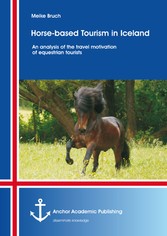Suchen und Finden
Mehr zum Inhalt

Horse-based Tourism in Iceland - An analysis of the travel motivation of equestrian tourists
Text sample: Chapter 2.2.2.2, The Icelandic Horse: The Icelandic Horse is a small horse which weighs about 360-370 kg and has an average height of withers of 138 cm (Helgadóttir, 2006: 537). Traditional characteristics of the Icelandic Horse are to be changed. New breeding goals are, for example, long-legged horses in order to address other target groups (ipzv.de. 2012a). Nevertheless, the core characteristics of the Icelandic Horses, power and temperament, will remain the same (ipzv.de, 2012a). The Icelandic Horse has 5 gaits (walk, trot, toelt, canter/gallop, and pace) and a wide variety of colours which distinguishes it from other horse breeds (Helgadóttir, 2006: 537). Within the riding community it is known for sport, family, dressage and gaits (Helgadóttir, 2006: 537). The breeding differs from the most breeds that are used in industrialized societies (Helgadóttir, 2006: 538). Most of the time the horses live in a herd in order to learn and respect the authority of the herd leader (Helgadóttir, 2006: 538). At the age of four or five the Icelandic Horse starts ist training (Helgadóttir, 2006: 538). In contrast, many dressage breeds are already trained as a yearling. This special horsemanship in Iceland is seen as a tradition and origin for the special Icelandic Horse character and manifested in the International Federation of Icelandic Horse Association goals (Helgadóttir, 2006: 538): 'To ensure that the Icelandic Horse is kept in conditions as close as possible to ist habit'. During the time of settlement in the 9th to the 20th century, the Icelandic horse '[...] was the most trusted servant in the farming society [...]' (Helgadóttir, 2006: 538). It was responsible for the transportation of goods and people, as well as for horsepower on the field (Helgadóttir, 2006: 538). After the industrialization the meaning of the Icelandic Horse changed completely. Today it is essential for recreation and sport and more a 'companion' rather than a 'servant' (Helgadóttir, 2006: 538). However, the special meaning of trust is still the same and a crucial aspect (Helgadóttir, 2006: 538). 2.2.2.3, The Landsmót: The Landsmót is the greatest horse-based event in Iceland and exists for more than 60 years (Landsmót.is, 2012a). It is on every two years repeating tournament and breeding show based on cultural tradition (Helgadóttir, 2006: 538). The first time the Landsmót took place was in 1950 (Landsmót.is, 2012a). Today it is known as the most important tournament for the worldwide Icelandic Horse community. Consequently, the Landsmót attracts many people to visit Iceland, as there is no comparable event due to the regulations and intension discussed in section 2.2.2.2. Even the world championship, which is as well a major event for the Icelandic community, does not have this status. Every two years the World Championship takes place in another country alternatively to Landsmót. Logically Iceland is not a host country and Iceland's very best horses are not allowed to leave the island for participation in this tournament. As a result, the very best horses can only be seen in Iceland at the Landsmót, which means travelling. The Landsmót in 2010 could not take place due to a communicable horse disease (Landsmót.is, 2012b). Despite that no horses are imported into the country; germs can be carried through tourists. Due to the actual safeguard measures against diseases and genetic mixing, the immunization of horses is not common. The Icelanders are also afraid of deadened germs in medication. The disaster spread out to almost every horse of the island and the tournament could not take place (Landsmót.is, 2012b). As a response, the Landsmót was extraordinarily moved to 2011, despite the fact that this was a year of World Championship year. The next regular tournament will take place in 2012 in order to return to the two-year-rhythm (Landsmót.is, 2012b). 2.3, Tourist behaviour: Tourist behaviour matters to tourists, as well as '[...] to people who are making decisions about tourists', e.g. tour operators or tourism boards (Pearce, 2005: 6). It is connected to marketing activities and supports the growth and existence of many small businesses (Pearce, 2005: 8). Moreover, tourism behaviour has 'socio-cultural', as well as 'environmental impacts' (Pearce, 2005: 8). As stated above, especially small businesses in Iceland, like farms, depend on tourism after the crisis. Additionally, as tourism behaviour relates to tourism issues like 'globalization' or 'localization', it mainly influences '[...] financial decisions on infrastructure investment [...]' (Pearce, 2005: 8) of the destination, but receives '[...] little attention in governmental policies' (Pearce, 2005: 8). In the case of Iceland it followed this non-governmental interest until the crisis shocked ist economy. Therefore, tourist behaviour is essential for analysing tourism motivation and consequently an important part of this study.
Alle Preise verstehen sich inklusive der gesetzlichen MwSt.







